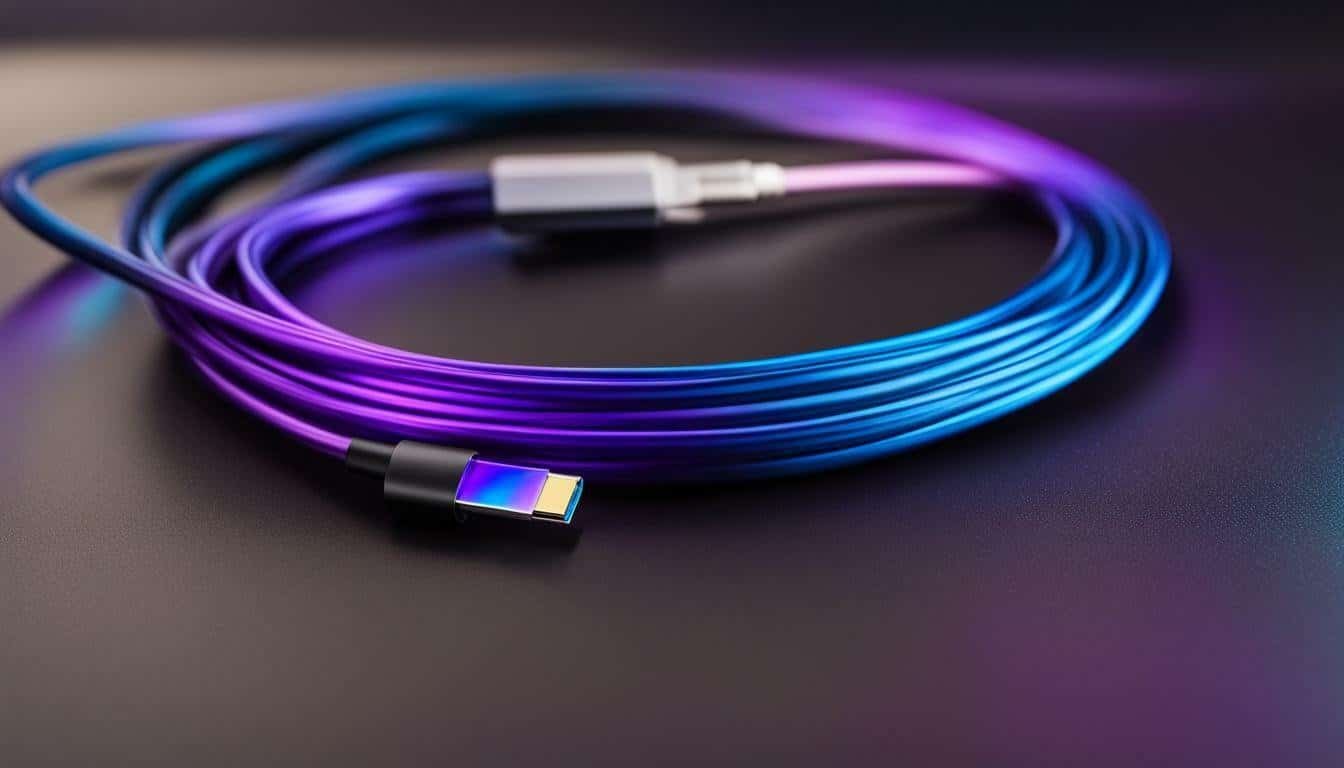Welcome to my guide on KVM switches! If you’re unfamiliar with KVM switches or want to learn more about how to maximize their use, you’ve come to the right place. Throughout this article, I’ll take you through the basics of understanding KVM switches, how they work, the different types available, and the benefits of using them. I’ll also walk you through key features to consider when choosing a KVM switch, offer guidance on selecting the right one, and provide a step-by-step guide on setting it up.
Key Takeaways:
- KVM switches are essential tools that allow users to control multiple computers using a single keyboard, video monitor, and mouse set (KVM).
- There are different types of KVM switches available, including desktop, rack-mounted, and IP-based switches.
- Using a KVM switch can increase productivity, save space, and simplify management.
- When choosing a KVM switch, it’s important to consider features like the number of ports, video resolutions supported, and compatibility with operating systems.
- With the right KVM switch, users can unlock the full potential of their computing setup and achieve an enhanced experience.
Understanding KVM Switches
As a copywriting journalist, I’ve often come across the term ‘KVM switch’ when researching technology and computing products. If you’re also unfamiliar with this term, don’t worry – I’m here to help demystify it for you.
A KVM switch, also known as a keyboard-video-mouse switch, is a hardware device that enables users to control multiple computers using a single set of keyboard, video monitor, and mouse. With a KVM switch, you can easily switch between connected computers without the need for additional input devices.
Whether you’re a professional with multiple workstations, a gamer with multiple computers, or a home user with a personal computer and laptop, a KVM switch can be a valuable tool for streamlining your computing experience.
How Does a KVM Switch Work?
A KVM switch enables you to control multiple computers using a single keyboard, video monitor, and mouse set (KVM). But how exactly does it work?
When you connect multiple computers to a KVM switch, it acts as a central hub that allows you to send keyboard, mouse, and video signals to each computer. The KVM switch takes input from the keyboard, mouse, and video, and forwards it to the selected computer. The selected computer then sends output back to the KVM switch, which in turn forwards it to the keyboard, mouse, and video.
To switch between computers, you can use physical buttons on the KVM switch or hotkeys on the keyboard. Most KVM switches also allow you to switch between computers automatically based on activity detection or time intervals that you specify.
Some advanced KVM switches even offer remote access, allowing you to control your computers from anywhere in the world using an internet connection.
Overall, a KVM switch simplifies the process of managing multiple computers and saves space while providing convenient and centralized control.
Types of KVM Switches
There are different types of KVM switches available in the market, each with unique features and use cases.
| Type | Description |
|---|---|
| Desktop KVM Switches | These switches are designed for use with a few computers in a small office or home environment. They come in various port configurations ranging from 2 to 8 ports, making them ideal for individuals who need to switch between multiple computers using a single keyboard, mouse, and monitor. |
| Rack-mounted KVM Switches | These switches are mounted on a server rack and allow users to control multiple servers from a single console. They typically come with a higher port count, ranging from 8 to 32 ports. Rack-mounted KVM switches are commonly used in data centers and server rooms. |
| IP-based KVM Switches | These switches offer remote access capabilities, allowing users to control connected computers from anywhere in the world. They also provide multi-user access, which enables multiple users to connect to a single computer simultaneously. IP-based KVM switches are ideal for businesses with remote branches or offsite employees. |
Choosing the right type of KVM switch will depend on your specific needs and requirements.
Benefits of Using a KVM Switch
Using a KVM switch comes with numerous benefits that can improve your computing experience. Here are some advantages to consider:
- Increased productivity: Rather than switching between multiple keyboards and mice, a KVM switch allows you to control multiple computers with a single set of peripherals. This eliminates the need to constantly switch between machines and can save you a significant amount of time.
- Space savings: A KVM switch helps reduce clutter by letting you control multiple computers with a single set of peripherals. This can be especially helpful if you have limited desk space or if you frequently move between workstations.
- Reduced equipment costs: With a KVM switch, you can consolidate multiple sets of peripherals into one, reducing the need for additional equipment and ultimately saving you money.
- Simplified management: A KVM switch allows you to manage multiple computers from a single console, making it easier to monitor and troubleshoot computers without having to physically access each one.
In essence, a KVM switch can help streamline your computing setup, save you time and money, and ultimately improve your productivity. But before you can take advantage of these benefits, it’s important to first understand which KVM switch is right for you.
Key Features to Consider
When choosing a KVM switch, it’s important to consider the features that will best suit your needs. Here are some key features to keep in mind:
| Feature | Description |
|---|---|
| Number of Ports | Determine how many computers you need to connect to the KVM switch. Make sure to choose a switch with enough ports to accommodate all your devices. |
| Video Resolutions Supported | Check the maximum video resolution the KVM switch can support. This is important if you use high-resolution monitors or display multiple video sources simultaneously. |
| USB Connectivity | Verify the KVM switch supports USB connections, especially if you plan to connect devices like printers, scanners, or external drives. |
| Hotkey Switching | Hotkey switching allows you to switch between connected devices by pressing a combination of keys on your keyboard, making it quicker and more convenient than using a physical button on the KVM switch. |
| Audio Capabilities | If you need to transmit audio signals from your computers to your speakers, check that the KVM switch supports audio input and output. |
By considering these features, you can narrow down your choices and find the KVM switch that will best fulfill your needs and preferences.
Choosing the Right KVM Switch
When it comes to selecting the right KVM switch, several factors must be considered to ensure that the switch meets your requirements. Here are some key factors that should guide your decision:
- Number of ports: Determine the number of computers you need to connect to the KVM switch and ensure that the switch has enough ports to accommodate your setup. Keep in mind that you may want to add more systems in the future, so choosing a switch with more ports than you currently need can save you the hassle and expense of upgrading later.
- Compatibility: Check the KVM switch’s compatibility with your computer’s operating system. Ensure that the switch supports the operating systems of all the computers you want to connect.
- Type of connection: Consider the type of connection you need. Most KVM switches provide USB connections, but some also offer PS/2 and serial connections. Ensure that the switch offers the type of connection you need.
- Video resolution: Check the video resolution supported by the KVM switch. If you have high-resolution monitors, ensure that the switch supports the resolution you need.
- Hotkey switching: Look for a KVM switch that supports hotkey switching. This feature allows you to switch between computers quickly and easily using a keyboard shortcut rather than manually selecting the system from the switch.
- Noise reduction: If you plan on placing the KVM switch in a noise-sensitive area, such as a recording studio, look for switches that offer noise reduction features to minimize interference and signal noise.
- Remote access: Consider whether you need remote access to your computers. If so, look for KVM switches that offer remote access capabilities.
KVM Switch Setup Guide
Setting up a KVM switch is a simple process that requires some basic technical knowledge. Follow these steps to get started:
- Identify the KVM switch’s input and output ports.
- Connect the keyboard, video monitor, and mouse to the KVM switch’s console ports.
- Connect each computer’s keyboard, video monitor, and mouse to the KVM switch’s computer ports.
- Power on the KVM switch and all connected computers.
- Use the KVM switch’s hotkeys or on-screen menu to switch between computers.
If you encounter any difficulties, refer to the KVM switch’s manual for troubleshooting tips.
It is recommended to test the KVM switch’s configurations once the installation is complete. This ensures that the switch is working correctly and that there are no connectivity issues.
Tip: Make sure that each computer’s keyboard and mouse are connected to USB ports on the KVM switch. This ensures that the KVM switch recognizes them, and your devices work correctly.
Exploring Advanced KVM Switch Features
Aside from the basic functions that KVM switches offer, some advanced features can further enhance the user experience. These features are especially useful for IT professionals and power users who need to perform complex tasks and manage multiple computers efficiently.
Remote Access
Some KVM switches come with remote access capabilities, allowing users to access and control their computers from anywhere with an internet connection. This feature is particularly helpful for remote workers or businesses with multiple branches. Remote access allows IT professionals to troubleshoot issues, install updates, and manage resources across all connected devices without being physically present at each location.
Multi-Monitor Support
Many modern KVM switches offer multi-monitor support, which enables users to connect and toggle between multiple monitors. This feature is useful for tasks that require multiple screens, such as video editing, graphic design, or financial analysis.
Server Management Software Integration
Some KVM switches come with server management software, which allows users to manage and monitor data centers, server rooms, and IT infrastructure. The software allows for remote power cycling, hardware monitoring, and virtual media support across multiple servers from a single interface. This feature is particularly useful for IT professionals who need to manage large-scale data centers or server farms.
Overall, advanced KVM switch features can greatly improve productivity and efficiency when managing multiple computers or servers. It is important to assess individual needs and requirements and choose a KVM switch with the appropriate features to unlock its full potential.
Conclusion
In conclusion, KVM switches are a valuable tool for anyone looking to streamline their computing experience. By allowing users to control multiple computers using a single KVM set, KVM switches offer increased productivity, space savings, and simplified management. When choosing a KVM switch, consider the number of ports, video resolutions supported, USB connectivity, hotkey switching, and audio capabilities. Additionally, take into account the number of computers to be connected, compatibility with operating systems, and future scalability. Setting up a KVM switch is straightforward, requiring only connecting cables, configuring settings, and troubleshooting common issues. Advanced features like remote access, multi-monitor support, and integration with server management software can further enhance the KVM switch experience. Overall, by understanding and utilizing the full potential of KVM switches, users can achieve a more efficient and effective computing setup. So why not unlock the full potential of your KVM switch today?What Are the Main Benefits of Using a USB KVM Switch?
A usb kvm switch control devices efficiently, allowing users to manage multiple computers using a single set of peripherals. This versatile device saves desk space and eliminates the need for multiple keyboards, mice, and monitors. With seamless switching between systems, it enhances productivity, streamlines workflow, and reduces clutter.
What are the Features to Consider When Purchasing a Hacking Desktop?
When purchasing a hacking desktop, there are essential features to consider. First, ensure the processor is powerful enough to handle intensive tasks. Opt for a fast and efficient RAM to support multitasking. A large storage capacity is crucial for saving vast amounts of data. Choose a hacking desktop with a reliable network card for seamless connectivity. Additionally, prioritize a robust security system to protect against potential threats. Overall, these hacking desktop essentials are vital for optimizing your hacking experience.
Can You Explain the Basics of KVM Switches in a Simplified and Understandable Way?
Kvm switches demystified: KVM, or Keyboard, Video, and Mouse, switches simplify the management of multiple computers. With a KVM switch, you can control multiple devices using a single set of peripherals. By pressing a button or using hotkeys, you seamlessly switch between computers, reducing clutter and enhancing productivity. It ensures convenient, centralized control over different systems, making tasks smoother and more efficient. KVM switches simplify complexity, offering a streamlined solution for managing multiple devices effortlessly.
FAQ
Q: What is a KVM switch?
A: A KVM switch, short for keyboard, video, and mouse switch, is a hardware device that allows users to control multiple computers using a single keyboard, video monitor, and mouse set.
Q: How does a KVM switch work?
A: A KVM switch works by allowing users to switch between different connected computers using hotkeys, buttons, or software. It connects to the computers and peripherals using cables and enables control of the computers through a single set of input devices.
Q: What are the different types of KVM switches?
A: There are various types of KVM switches available, including desktop KVM switches, rack-mounted KVM switches, and IP-based KVM switches. Each type has its own features and use cases.
Q: What are the benefits of using a KVM switch?
A: Using a KVM switch provides several benefits, such as increased productivity by simplifying the management of multiple computers, space savings by reducing the need for multiple keyboards and mice, cost savings by eliminating the need for extra peripherals, and streamlined control and operation of connected computers.
Q: What key features should I consider when choosing a KVM switch?
A: When choosing a KVM switch, it’s important to consider features like the number of ports, supported video resolutions, USB connectivity, hotkey switching capabilities, and audio support.
Q: How do I choose the right KVM switch for my needs?
A: To choose the right KVM switch, consider factors such as the number of computers you need to connect, compatibility with your operating systems, and the potential for future scalability.
Q: How do I set up a KVM switch?
A: Setting up a KVM switch involves connecting the cables to the computers and peripherals, configuring any necessary settings, and troubleshooting common issues that may arise during the setup process.
Q: What advanced features can some KVM switches offer?
A: Some advanced KVM switches may offer features like remote access, multi-monitor support, and integration with server management software, providing additional functionality and convenience for users.

![Top & Best Processors For Hacking: [High-Performance CPUs]](https://nondevelopers.com/wp-content/uploads/2023/06/Best-Processors-for-hacking.jpg)


0 Comments